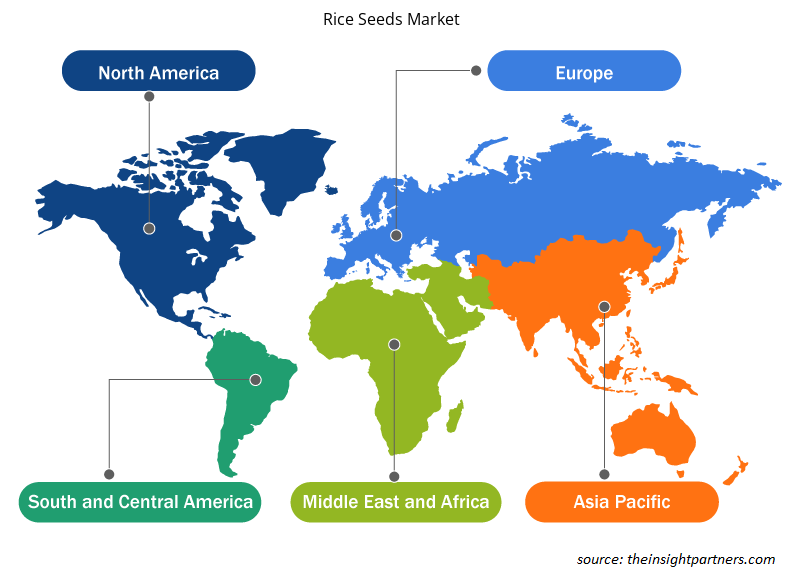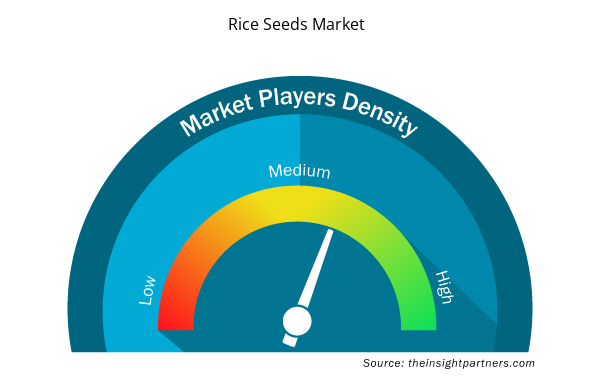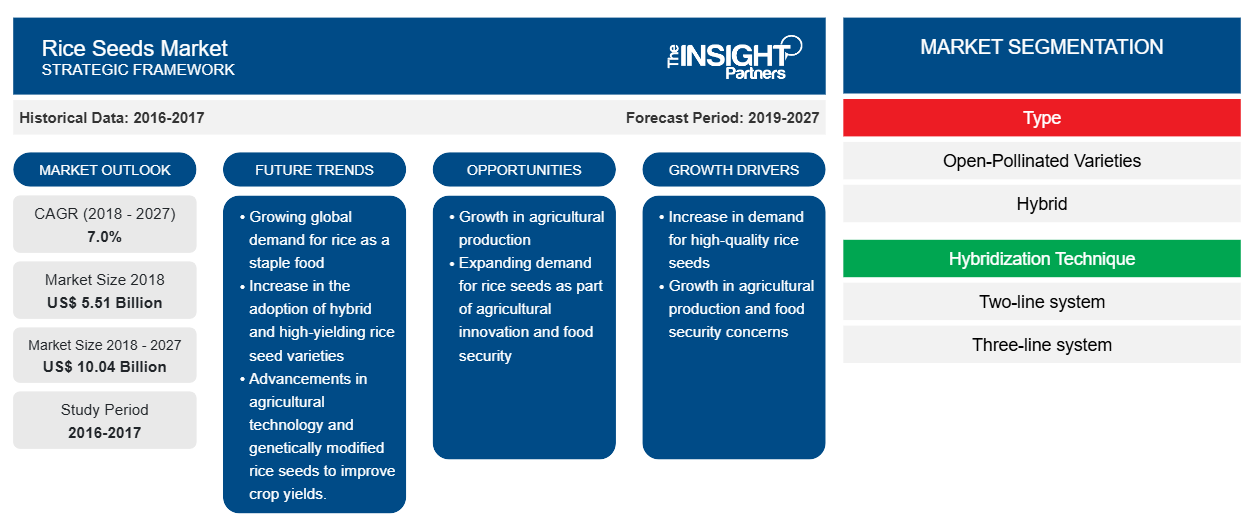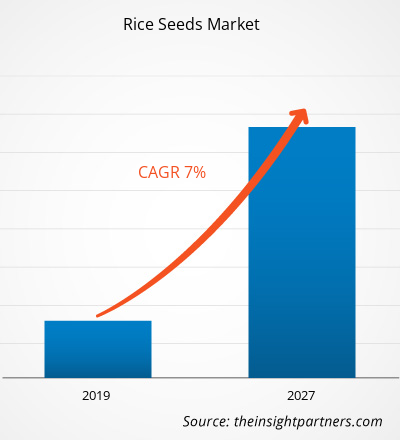米種子市場は2018年に55億680万米ドルと評価され、2027年までに100億3600万米ドルに達すると予測されており、2019年から2027年にかけて7.0%のCAGRで成長すると予想されています。
米は、多くの主要国、特にアジア太平洋地域で主食となっています。米の種子はパディとも呼ばれ、米の種子全体を指します。パディ 1 粒には米の粒が 1 つ含まれています。これは、Oryza glaberrima または L. Oryza sativa の種子です。さらに、米の種子は、ペプチドや治療用タンパク質などのヒト用医薬品を製造するためのバイオリアクターとして使用されています。
アジア太平洋地域の稲種子市場は、予測期間中に最高のCAGRで成長すると予想されています。この地域の市場の成長は、主にインドや中国などの国で継続的に増加している高い人口密度に起因しています。これに加えて、アジア諸国に居住する人口の約4分の1が貧困層に属しています。これらの国々は、アジア太平洋諸国の米の消費を牽引すると予想されています。しかし、所得がかなり高い日本や韓国などの国では、一人当たりの米の消費量は減少し始めています。人口の増加と栽培面積の不足は、世界の稲種子市場で対処する必要がある2つの主要な問題です。アジア太平洋地域全体で高まる需要を満たすために、稲作の生産性を高めることが強く求められています。
要件に合わせてレポートをカスタマイズする
このレポートの一部、国レベルの分析、Excelデータパックなど、あらゆるレポートを無料でカスタマイズできます。また、スタートアップや大学向けのお得なオファーや割引もご利用いただけます。
- このレポートの主要な市場動向を入手してください。この無料サンプルには、市場動向から見積もりや予測に至るまでのデータ分析が含まれます。
市場分析
生産性向上のためのハイブリッド種子の採用増加がイネ種子市場の成長を加速させると期待される
世界人口の増加に伴い、今後数年間で増加する食糧消費を満たすための米の需要が高まると予想されています。しかし、水と土地資源が限られているため、米の生産量の増加は農家にとって課題となっています。この問題に対処する唯一の解決策は、米種子の生産性を高めることです。過去数年間、世界の一部の地域では、米の生産性が停滞または低下していますが、これは主に米の収穫量の潜在的改善がわずかだったためです。ハイブリッド種子の開発は、各国が米の生産性を高め、米の自給自足を達成するための解決策を提供します。分子生物学、バイオテクノロジー、ゲノミクスの分野における技術の進歩により、ハイブリッド米の育種は大幅に改善されました。これに加えて、ハイブリッド米種子生産の分野における継続的な研究開発投資と官民パートナーシップ(PPP)の傾向の高まりにより、特に商業農家の間でハイブリッド種子の採用がさらに増加しています。これらすべての要因により、予測期間中にハイブリッド種子の需要が促進されると予想されます。
タイプインサイト
米種子市場は種類によって開放受粉品種とハイブリッド品種に分かれている。開放受粉品種(OPV)のイネ種子は、親植物の自然受粉の結果です。このカテゴリの受粉方法には、自家受粉、昆虫、鳥、その他の自然手段による受粉が含まれます。ハイブリッド種子とは異なり、これらの種子は親植物と同一の植物を生み出し、場合によっては標準品種として知られています。OPVの選択は、栽培者の要件によって異なります。OPVは、効率的に維持および生産されれば、増殖しても同じ特性を保持します。OPVイネ種子は、地域の生育条件と気候に基づいてゆっくりと適応するため、より遺伝的に多様な特性を示します。商業栽培者は、高収量と特定の望ましい特性のために、OPVよりもハイブリッド種子を好みます。ハイブリッド種子はOPVよりもいくつかの利点がありますが、OPVは植物の遺伝的多様性の保全に役立ちます。自然栽培の米やその他の食品に対する世界的な需要の増加は、今後数年間でOPV市場を牽引すると予想されます。
ハイブリダイゼーション技術の洞察
交配技術に基づいて、イネ種子市場は2系統システムと3系統システムに分割されています。2系統システムセグメントは、2018年に最大の市場シェアを占めました。2系統ハイブリッドの利点には、維持系統が不要であること、雑種交配種を開発するための親の選択肢が広いこと、不妊細胞質による悪影響がないことが挙げられます。全体的な2系統種子生産は、3系統ハイブリッドとそれほど変わりません。2系統ハイブリッド種子生産における重要な考慮事項の1つは、適切な場所または季節の決定です。2系統システムが提供する利点は、予測期間中に2系統ハイブリッドの需要を促進すると予想されます。
米種子市場で事業を展開している企業としては、BASF SE、Bayer AG、DuPont de Nemours、Inc.、Guard Rice Mills、Kaveri Seeds、Mahyco、Nuziveedu Seeds Limited、Rallis India Limited、Rasi Seeds (P) Ltd.、SL-Agritech などがあります。主要企業は合併や買収、研究開発戦略を実施して顧客基盤を拡大し、世界市場で大きなシェアを獲得し、それによって世界的にブランド名を維持しています。
レポートの注目点
- 米種子市場における進歩的な業界動向は、プレーヤーが効果的な長期戦略を策定するのに役立ちます。
- 先進国市場と発展途上国市場で採用されているビジネス成長戦略
- 2019年から2027年までの米種子市場の定量分析
- 世界のイネ種子需要の推定
- 業界で事業を展開するバイヤーとサプライヤーの有効性を示すPEST分析
- 競争市場の状況を理解するための最近の動向
- 市場動向と見通し、および米種子市場の成長を牽引・抑制する要因
- 商業的利益の基盤となる市場戦略を強調し、市場の成長につながる意思決定プロセスを支援する
- さまざまなノードにおける米種子市場規模
- 市場の詳細な概要とセグメンテーション、および米種子業界の動向
- 有望な成長機会のあるさまざまな地域の米種子市場の規模
稲の種
米種子市場の地域別分析
予測期間を通じて米種子市場に影響を与える地域的な傾向と要因は、Insight Partners のアナリストによって徹底的に説明されています。このセクションでは、北米、ヨーロッパ、アジア太平洋、中東、アフリカ、南米、中米にわたる米種子市場のセグメントと地理についても説明します。

- 米種子市場の地域別データを入手
米種子市場レポートの範囲
| レポート属性 | 詳細 |
|---|---|
| 2018年の市場規模 | 55億1000万米ドル |
| 2027年までの市場規模 | 100.4億米ドル |
| 世界のCAGR(2018年 - 2027年) | 7.0% |
| 履歴データ | 2016-2017 |
| 予測期間 | 2019-2027 |
| 対象セグメント | タイプ別
|
| 対象地域と国 | 北米
|
| 市場リーダーと主要企業プロフィール |
|
米種子市場のプレーヤー密度:ビジネスダイナミクスへの影響を理解する
米種子市場は、消費者の嗜好の変化、技術の進歩、製品の利点に対する認識の高まりなどの要因により、エンドユーザーの需要が高まり、急速に成長しています。需要が高まるにつれて、企業は提供品を拡大し、消費者のニーズを満たすために革新し、新たなトレンドを活用し、市場の成長をさらに促進しています。
市場プレーヤー密度とは、特定の市場または業界内で活動している企業または会社の分布を指します。これは、特定の市場スペースに、その規模または総市場価値と比較して、どれだけの競合相手 (市場プレーヤー) が存在するかを示します。
米種子市場で事業を展開している主要企業は次のとおりです。
- BASF SE
- バイエルAG
- EI デュポン ド ヌムール アンド カンパニー
- ガードライスミルズ
- カヴェリシードカンパニー
免責事項:上記の企業は、特定の順序でランク付けされていません。

- 米種子市場のトップキープレーヤーの概要を入手
米種子市場 - 種類別
- 開放受粉品種(OPV)
- ハイブリッド
稲種子市場 – 交配技術による
- 2ラインシステム
- 3ラインシステム
米種子市場 – 処理別
- 治療済み
- 未処理
米種子市場 – 粒の大きさ別
- 長粒種
- 中粒
- 短粒種
企業プロフィール
- 過去2年間の分析、基準年、CAGRによる予測(7年間)
- PEST分析とSWOT分析
- 市場規模価値/数量 - 世界、地域、国
- 業界と競争環境
- Excel データセット



Report Coverage
Revenue forecast, Company Analysis, Industry landscape, Growth factors, and Trends

Segment Covered
This text is related
to segments covered.

Regional Scope
North America, Europe, Asia Pacific, Middle East & Africa, South & Central America

Country Scope
This text is related
to country scope.
Trends and growth analysis reports related to Food and Beverages : READ MORE..
The List of Companies
- BASF SE
- Bayer AG
- E. I. du Pont de Nemours and Company
- Guard Rice Mills
- Kaveri Seed Company Ltd
- Maharastra Hybrid Seeds Company Private Limited (Mahyco)
- Nuziveedu Seeds Ltd. (NSL)
- Rallis India Limited
- Rasi Seeds (P) Ltd
- SL Agritech Corporation
The Insight Partners performs research in 4 major stages: Data Collection & Secondary Research, Primary Research, Data Analysis and Data Triangulation & Final Review.
- Data Collection and Secondary Research:
As a market research and consulting firm operating from a decade, we have published and advised several client across the globe. First step for any study will start with an assessment of currently available data and insights from existing reports. Further, historical and current market information is collected from Investor Presentations, Annual Reports, SEC Filings, etc., and other information related to company’s performance and market positioning are gathered from Paid Databases (Factiva, Hoovers, and Reuters) and various other publications available in public domain.
Several associations trade associates, technical forums, institutes, societies and organization are accessed to gain technical as well as market related insights through their publications such as research papers, blogs and press releases related to the studies are referred to get cues about the market. Further, white papers, journals, magazines, and other news articles published in last 3 years are scrutinized and analyzed to understand the current market trends.
- Primary Research:
The primarily interview analysis comprise of data obtained from industry participants interview and answers to survey questions gathered by in-house primary team.
For primary research, interviews are conducted with industry experts/CEOs/Marketing Managers/VPs/Subject Matter Experts from both demand and supply side to get a 360-degree view of the market. The primary team conducts several interviews based on the complexity of the markets to understand the various market trends and dynamics which makes research more credible and precise.
A typical research interview fulfils the following functions:
- Provides first-hand information on the market size, market trends, growth trends, competitive landscape, and outlook
- Validates and strengthens in-house secondary research findings
- Develops the analysis team’s expertise and market understanding
Primary research involves email interactions and telephone interviews for each market, category, segment, and sub-segment across geographies. The participants who typically take part in such a process include, but are not limited to:
- Industry participants: VPs, business development managers, market intelligence managers and national sales managers
- Outside experts: Valuation experts, research analysts and key opinion leaders specializing in the electronics and semiconductor industry.
Below is the breakup of our primary respondents by company, designation, and region:

Once we receive the confirmation from primary research sources or primary respondents, we finalize the base year market estimation and forecast the data as per the macroeconomic and microeconomic factors assessed during data collection.
- Data Analysis:
Once data is validated through both secondary as well as primary respondents, we finalize the market estimations by hypothesis formulation and factor analysis at regional and country level.
- Macro-Economic Factor Analysis:
We analyse macroeconomic indicators such the gross domestic product (GDP), increase in the demand for goods and services across industries, technological advancement, regional economic growth, governmental policies, the influence of COVID-19, PEST analysis, and other aspects. This analysis aids in setting benchmarks for various nations/regions and approximating market splits. Additionally, the general trend of the aforementioned components aid in determining the market's development possibilities.
- Country Level Data:
Various factors that are especially aligned to the country are taken into account to determine the market size for a certain area and country, including the presence of vendors, such as headquarters and offices, the country's GDP, demand patterns, and industry growth. To comprehend the market dynamics for the nation, a number of growth variables, inhibitors, application areas, and current market trends are researched. The aforementioned elements aid in determining the country's overall market's growth potential.
- Company Profile:
The “Table of Contents” is formulated by listing and analyzing more than 25 - 30 companies operating in the market ecosystem across geographies. However, we profile only 10 companies as a standard practice in our syndicate reports. These 10 companies comprise leading, emerging, and regional players. Nonetheless, our analysis is not restricted to the 10 listed companies, we also analyze other companies present in the market to develop a holistic view and understand the prevailing trends. The “Company Profiles” section in the report covers key facts, business description, products & services, financial information, SWOT analysis, and key developments. The financial information presented is extracted from the annual reports and official documents of the publicly listed companies. Upon collecting the information for the sections of respective companies, we verify them via various primary sources and then compile the data in respective company profiles. The company level information helps us in deriving the base number as well as in forecasting the market size.
- Developing Base Number:
Aggregation of sales statistics (2020-2022) and macro-economic factor, and other secondary and primary research insights are utilized to arrive at base number and related market shares for 2022. The data gaps are identified in this step and relevant market data is analyzed, collected from paid primary interviews or databases. On finalizing the base year market size, forecasts are developed on the basis of macro-economic, industry and market growth factors and company level analysis.
- Data Triangulation and Final Review:
The market findings and base year market size calculations are validated from supply as well as demand side. Demand side validations are based on macro-economic factor analysis and benchmarks for respective regions and countries. In case of supply side validations, revenues of major companies are estimated (in case not available) based on industry benchmark, approximate number of employees, product portfolio, and primary interviews revenues are gathered. Further revenue from target product/service segment is assessed to avoid overshooting of market statistics. In case of heavy deviations between supply and demand side values, all thes steps are repeated to achieve synchronization.
We follow an iterative model, wherein we share our research findings with Subject Matter Experts (SME’s) and Key Opinion Leaders (KOLs) until consensus view of the market is not formulated – this model negates any drastic deviation in the opinions of experts. Only validated and universally acceptable research findings are quoted in our reports.
We have important check points that we use to validate our research findings – which we call – data triangulation, where we validate the information, we generate from secondary sources with primary interviews and then we re-validate with our internal data bases and Subject matter experts. This comprehensive model enables us to deliver high quality, reliable data in shortest possible time.


 このレポートの無料サンプルを入手する
このレポートの無料サンプルを入手する